Prey Drive: A Frontline Perspective

If you have a dog, chances are you have heard all about their prey drive and their love of food – especially meat. As a former kennel technician at a dog boarding facility, I have seen food motivation take both funny turns, such as when a hound mix tried to eat directly from the facility’s bin of kibble, and dangerous ones, such as when a young dog dragged her owner out the door to chase a squirrel in the parking lot. Prey drive and food motivation are natural, but they need to be managed for everyone’s sake.
The consequences of an untethered prey drive can hurt both people and pets. For one thing, as mentioned above, your dog could try to jerk you around on the leash, putting both you and her in danger. If a dog is this determined when you are by his side, he may get worse without supervision. Many dogs, especially hounds and terriers, cannot be trusted to be outside alone, even in a fenced yard, because they may dig under or climb over barriers to chase prey, potentially getting lost or running into traffic. You must also consider the risk of or to the prey animal; your dog could go after a rabid squirrel, a venomous snake, or the neighbor’s cat. Nobody wants to deal with high vet bills or unhappy neighbors. Additionally, prey drive is not necessarily limited to living beings; some dogs may chase inanimate objects, including cars. This is bad for dogs, drivers, and vehicles alike.
Many things can affect a dog’s prey drive. For one thing, breed can be a factor; dog breeds that were bred to hunt- such as terriers, gun dogs, and hounds- are likely, in many cases, to love to to chase, as are dogs that are mixed with these breeds. Age can also be a factor; senior dogs will have less energy to chase a cat down the block, but young puppies may still be developing their predatory instincts . However, neither of these factors guarantees a high or low prey drive.
At my work, there were two female golden retrievers within three months of the same age. When squirrels came to the edge of the fence, one dog would chase them the whole length of the yard while barking and whining, but the other remained engrossed in scratching her back and attacking her tail. Also, large dogs aren’t the only hunters; two of the most squirrel-crazy dogs I met at work were a toy cockapoo and a West Highland White Terrier.
As you can see, many factors can affect the thrill of the chase. The age, personality, and breed makeup of your dog can have an impact, but so can her environment. Believe it or not, there are dogs that are perfectly calm inside but feel their hunting instincts kick in when they’re experiencing the sights, sounds, and smells of nature. This is important information if you have a cat (or, in extreme cases, a smaller dog) that gets let outside with your large(r) dog. Additionally, dogs vary in what they see as prey. Some may attempt to hunt larger animals, like deer, and some may not, while some learn to ignore pets, and others are too tempted. It is essential to think carefully about breeds, personalities, and living arrangements if you want a multi-pet home.
The good news is that prey drive can be reined in with training, and there’s a simple formula to remember: distance, duration, and distraction, or the “three Ds.” Focusing on the first point, distance, it would be ideal if your dog could follow a “leave it” command whenever it sees a potential prey item. You can train this by having your dog ignore a “low-value” toy or treat and giving them a favorite toy or treat in exchange. It is also important to teach your dog good leash manners and keep them leashed in situations where it’s unsafe to hunt if they have a high prey drive. Retractable leashes can be either a blessing or a curse; used properly; they allow you to give the dog less space when you see a distraction, but you MUST be sure to lock them once they’re adjusted, or else your pup will likely charge ahead of you.
However hard you try, instincts can sometimes get the best of dogs, so it’s important to have distraction techniques for once they begin stalking. “Come,” “lie down,” and “watch me” are essential commands to teach your dog, as they give her something to do besides hunt. If the dog is on leash, coming to a halt and telling him “watch me” and “heel” can quickly curb pulling.
Training your pup to “come” works especially well if you throw an item that is interesting but not intriguing, like a towel, that he will chase, and tell him to “drop it” before returning to you. Exhausting your pup before walks can be a good way to prevent distraction while walking, and you can do this especially well with a game of fetch, chase, or tug-o-war. Speaking of chase, there is a type of toy called a flirt pole that is a big hit with dogs who like to hunt. With a plush or feathered toy on the end, it looks a lot like a cat teaser toy, and you use it by sweeping it along the ground (holding it up can cause injury when the dog jumps), occasionally allowing the dog to catch it.
It is said that absence makes the heart grow fonder, but if a dog is stalking fellow pets, creating space between them to call off the chase. Crates, high gates, and cat furniture are all potential solutions depending on the situation. Of course, you also want to use your own judgement, and if a dog is being very persistent or has almost injured your animal, it might be time to get professional help, rehome him, or permanently separate him from other pets. On the other hand, most dogs can read fellow pets’ signals fairly well, so if the behavior is new and the dog is not actually injuring the other pet, a loud hiss or sudden snarl may make her quit before you have to intervene.
Prey drive is natural, but it can easily turn dangerous, and not just for the animal being chased. Luckily, there are many ways to train, distract, monitor, and exhaust your pup. Additionally, if you look for a dog at a rescue or shelter, you may find information about his personality, including how he may have interacted with other pets. Like your dog on the hunt, you need to be alert and follow your instincts to be successful. However, with the right tools and techniques, you can prevent her from hurting herself, other pets, or property.
by Katrina Thomas
